The pineal gland: a structure that has fascinated medical professionals, philosophers, and mystics alike.
I. A Millennial Journey of Mysterious Exploration
The pineal gland, a pea-sized organ deep within the brain, has long been a special conduit for the fusion of Eastern and Western wisdom. The ancient Roman physician Galen discovered this pinecone-shaped structure during dissections and attributed to it the mystical mission of regulating life energy; the Tang Dynasty Taoist text “Huangting Jing” recorded the “Niwan Palace,” which had long predicted the extraordinary status of this gland; contemporary science has revealed its melatonin secretion function, providing a material explanation for this bridge connecting the energies of heaven and earth.
1. Ancient Roman Period
The earliest descriptions of the pineal gland and its possible functions are found in the eighth anatomical work of Galen (Claudius Galenus, ca. 130-ca. 210 CE), “On the Usefulness of the Parts of the Body.” He explained that its size and shape were similar to the seeds of clubmoss, hence its name. It was called a gland due to its appearance, and its function was similar to that of other glands in the body, which is to support the blood vessels. To understand Galen’s explanation, two points should be noted:
1. Galen referred to the lateral ventricles as the anterior ventricles, the third ventricle as the middle ventricle, and the fourth ventricle as the posterior ventricle;
2. Galen believed that the ventricles were filled with “psychic pneuma,” a refined, formless gas-like or vapor-like substance, which was the primary tool of the human soul.
Note: In the tripartite theory, it is important to distinguish between the soul (psyche) and the spirit (pneuma); in the dualistic theory, no distinction is made:
The “soul” (soul) refers to both the intangible and tangible aspects of a person, called Psyche in Greek, and all animals, including humans, have a body and a soul. The “spirit” (spirit), called pneuma in Greek, is related to wind and breath; the difference between humans and animals is that humans have a body, a soul, and a spirit, with the spirit being the divine aspect bestowed upon humans, through which humans communicate with the divine.
2. Byzantine Empire Period
Posidonius of Byzantium (late 4th century): Imagination originates from the front of the brain, reason from the middle, and memory from the back.
Nemesius of Emesa (ca. 400 CE): Imagination originates from the anterior ventricles, reason from the middle ventricles, and memory from the posterior ventricles. This latter theory persisted until the mid-16th century, despite many variations, with the most significant variation coming from the Arab physician Avicenna (980–1037 CE), who constructed a unique theory by projecting the psychological functions described in Aristotle’s “On the Soul” onto the brain’s ventricular system.
3. Middle Ages
Qusta ibn Luqa (864–923) in his essay “Soul and Spirit” combined Nemesius’s doctrine of ventricular location with Galen’s worm-like part between the middle and posterior ventricles (which controls the animal soul), pointing out that when a person recalls something, they look upward, lifting the worm-like part of the brain, opening the channel, and retrieving memory from the posterior ventricle; conversely, when a person thinks, they look downward, closing the channel of the worm-like part, protecting the “spirit” in the middle ventricle from being disturbed by memories in the posterior ventricle. This theory had a significant influence in 13th-century Europe.
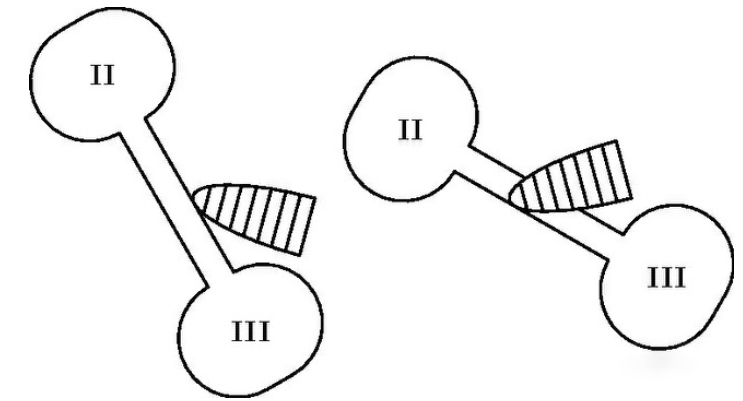
In later medieval literature, the term “pineal gland” was used to refer to the “worm-like” valve, thus reviving the view that the pineal gland regulates the flow of “spirit.” Galen would certainly have disagreed with this view, as the author overlooked the distinction Galen made between the pineal gland and the “worm-like part.” Mondino dei Luzzi (1306) further added to this unexplained confusion: the choroid plexuses in the lateral ventricles are the “worms” located between the anterior and middle ventricles that can open and close the channels, so in the late Middle Ages, the term “worm” could refer to at least three different parts of the brain: the vermis of the cerebellum, the pineal gland, and the choroid plexuses.
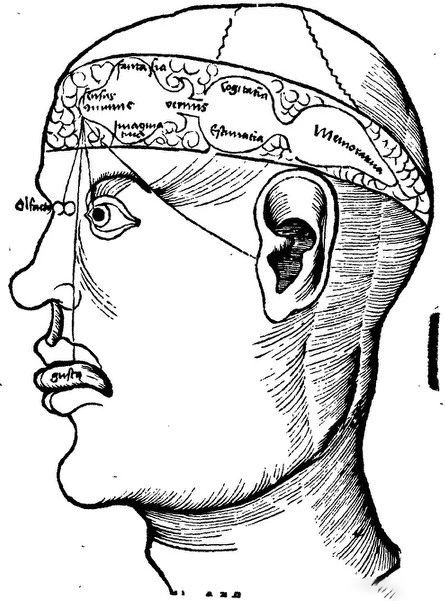
4. Renaissance
In the early 16th century, anatomy made significant progress, and from our perspective, at least two points are very important: first, Niccolò Massa (1536) discovered that the ventricles were not filled with gas or vapor-like “soul,” but with fluid (cerebrospinal fluid); second, Andreas Vesalius (1543) opposed all theories of ventricular location and the resulting theories that the choroid plexuses, pineal gland, and cerebellar vermis could regulate the flow of the soul within the ventricles.

Let’s focus on Descartes’ views on the pineal gland: Descartes (René Descartes, 1596–1650) is well-known to modern people for his contributions to mathematics and philosophy. Indeed, he once said
— I think, therefore I am.
He also
— invented the coordinate system and founded analytic geometry.
But he was also deeply interested in anatomy and physiology. His discussion of the pineal gland appears in his first book “Treatise of Man,” letters written between 1640-1641, and his last book “The Passions of the Soul.”
①. “Treatise of Man”
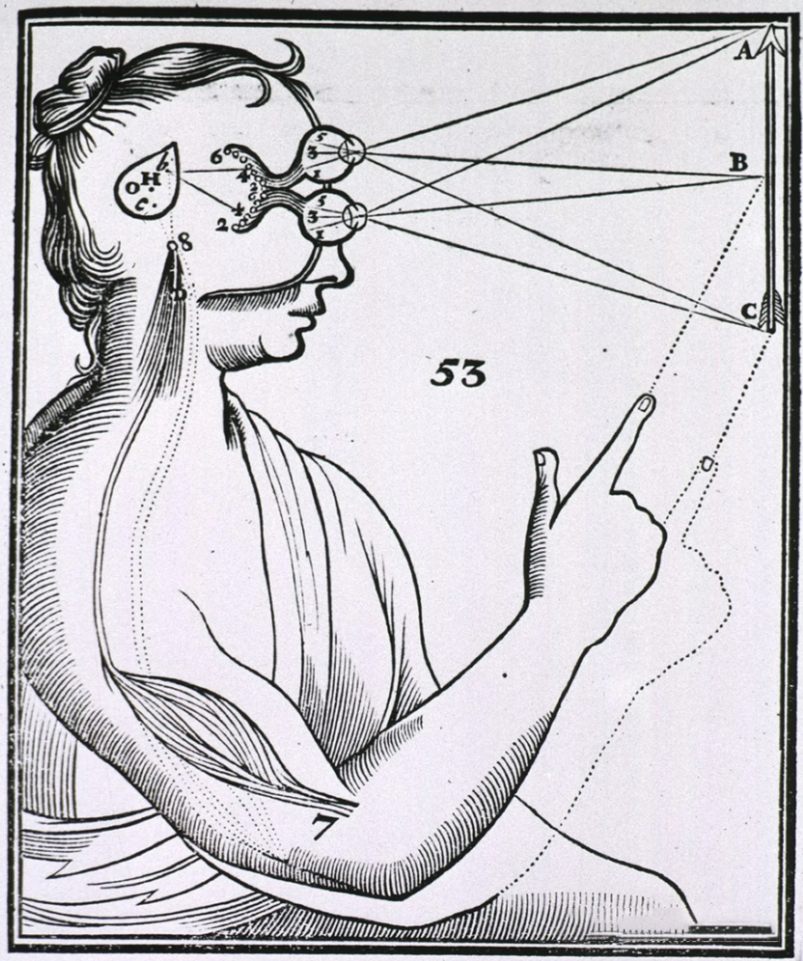
In this book, Descartes portrayed humans as a combination of a body (body) and soul (soul) created by God, with the “body” being merely a machine “I suppose the body to be nothing but a statue or machine made of earth, which God forms with the explicit intention of making it as much as possible like us” – I believe that the body is nothing more than a statue or machine made of earth, which God creates with the explicit intention of making it as much like us as possible. In academic philosophy, the psychological and physiological activities of the “body” are called the “soul.” In Descartes’ theory, the pineal gland plays an important role because it is involved in the production of sensation, imagination, memory, and movement. Unfortunately, some of Descartes’ anatomical and physiological assumptions were incorrect, both by the standards of his time and by today’s standards. First, Descartes believed that the pineal gland was suspended in the middle ventricle, which is not the case, as Galen had already pointed out. Second, Descartes believed that the pineal gland was filled with “souls” that were transported by small arteries surrounding it, but in fact, Galen had already pointed out that the pineal gland was surrounded by veins. Third, Descartes described the “animal soul” as “a gentle wind, or a lively and pure flame,” with the “soul” filling the ventricles like wind blowing on a sail, but 100 years earlier, Niccolò Massa (1536) had pointed out that the ventricles were filled with fluid, not gas. Additionally, Descartes explained bodily movement as follows: there are two types of bodily movement, one triggered by the movement of the pineal gland, and the other being reflexes (“souls” exchanged through channels between the two cerebral hemispheres, which differs from the modern anatomical concept of reflexes). The movement of the pineal gland is caused by 1. the power of the “soul”; 2. the “souls” wandering freely in the ventricles; and 3. stimulation from sensory organs.
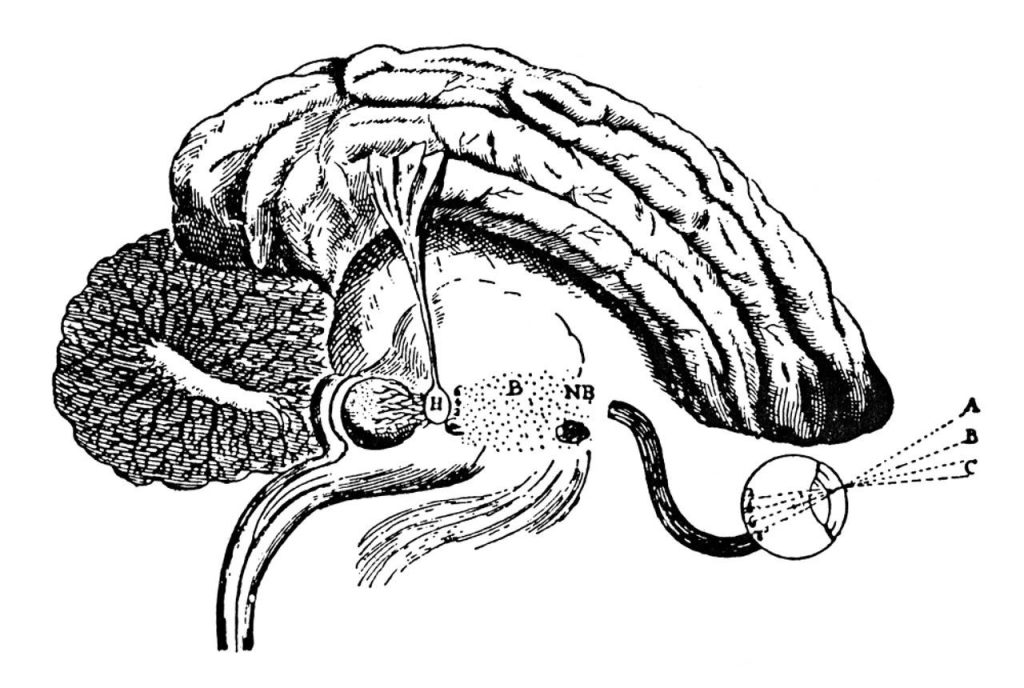
②. Descartes’ letters around 1640
My view is that this gland is the principal seat of the soul, and the place in which all our thoughts are formed. He gave the following reasons: “Apart from the pineal gland, I cannot find any part of the brain that does not appear in pairs; our two eyes see the same thing, our two ears hear the same sound, and only one thought can arise at a time, the impressions entering our eyes and ears must converge at some part of the body before being processed by the ‘soul,’ and no other part is more suitable than this gland. Being located at the center of the cranial cavity also provides the possibility for this purpose; it is surrounded by the infusion of ‘spirit’ brought by branches of the carotid artery.” Additionally, “the pineal gland is small, light, and easily movable,” so why is the pituitary gland not the seat of the soul? It is not paired either, “because the pituitary gland cannot move and is located outside the brain.” Regarding memory, Descartes said, “Memory exists not only in the cerebral hemispheres but also in the pineal gland and muscles,” and there is another form of memory that depends solely on the “soul” and is completely rational.
③. “The Passions of the Soul”
This was Descartes’ last published book, in which he elaborated his classic “mind-body dualism.” The book provides a more detailed description of the neurophysiology and neuropsychology of the pineal gland (although many of his views seem absurd and laughable today, in his time, Descartes was considered god-like). The lower and higher parts of the “soul” often come into conflict, and the small gland in the center of the brain (the pineal gland) can be pushed to one side by the “soul” and to the other side by the “spirit”; the force of the “spirit” pushing the gland to induce the “soul’s” desire for something, and the force of the “soul” pushing the gland in the opposite direction to avoid it, is the cause of this conflict.
5. After Descartes
During Descartes’ lifetime, his neurophysiological views on the pineal gland were not widely accepted, and after his death, this theory was almost universally rejected. Willis (1664): I can hardly believe this is the seat of the soul. Animals that seem to lack the higher faculties of the soul such as imagination and memory have larger pineal glands. Steensen (1669) pointed out: the anatomical basis assumed by Descartes is wrong because the pineal gland is not suspended in the middle ventricle and is surrounded by veins, not arteries.
①. Scientific Progress
Until 1828, Magendie still supported the theory rejected by Galen but supported by Qusta ibn Luqa: the pineal gland is a valve that opens and closes the aqueduct. Research on the pineal gland did not change until the second half of the 19th century, first with some scientists proposing a hypothesis: the pineal gland is a vestige of systemic development, a degenerated “third eye.” Revised theories based on this still exist today. Secondly, some scientists hypothesized that the pineal gland is an endocrine organ, and this theory was basically established in the 20th century. In 1958, the hormone secreted by the pineal gland, melatonin, was first isolated. In the 1990s, melatonin was hailed as a “panacea” and became the best-selling nutrient.
②. Pseudoscience
Although the pineal gland’s status in philosophy has diminished, it is extremely popular in some pseudoscientific fields. By the end of the 19th century, the founder of Theosophy, Blavatsky (author of “The Secret Doctrine”), linked the “third eye” discovered by comparative anatomists of her time with the “eye of Shiva” believed in by “Indian mystics,” concluding that the pineal gland is the vestige of this “spiritual visual organ” after its degeneration.
The sixth chakra, the Ajna chakra, in the Kundalini doctrine of Hinduism also maps to the pineal gland, and this doctrine is also associated with Tantra and Yoga.
The Niwan Palace and the opening of the heavenly eye in Chinese Taoism also map to the pineal gland. “Ziqing Zhixuan Ji”: “There are nine palaces in the head, corresponding to the nine heavens; the middle palace is called Niwan, also known as Huangting, Kunlun, and Tian Gu, with many names.” “Dongzhen Taishang Daojun Yuandan Shangjing”: “There are nine palaces in the head: one inch above the space between the eyebrows is the Mingtang Palace, two inches in is the Dongfang Palace, three inches in is the Dantian Palace, four inches in is the Liuzhu Palace, five inches in is the Yudi Palace; the Dantian Palace is the Niwan Palace, which is also the location of the pineal gland.”
Reference: “Stanford Encyclopedia of Philosophy”
II. The Evolution of Multiple Identities in the River of Civilization
1. The Spiritual Hub of Ancient Greek Medicine
Galen proposed revolutionary insights in “On the Usefulness of the Parts of the Body”: this structure located at the top of the third ventricle is not only the center of fluid regulation but also the abode of the soul (pneuma). He divided the human body into three energy channels – arteries carrying “vital spirit,” veins transporting “natural spirit,” and nerves transmitting “animal spirit,” with the pineal gland being the convergence point of these three systems.
2. The Energy Center of Eastern Cultivation Systems
Taoist internal alchemy texts describe in detail the cultivation path of the “Niwan Nine Palaces”: the “heavenly eye” between the eyebrows corresponds to the pineal gland region in modern anatomy, and the “Upper Dantian Niwan Palace” mentioned in the “Huangting Jing” forms an energy matrix with the pituitary and pineal glands. The “manifestation of sexual light” triggered by meditation essentially activates the photosensitive function of the pineal gland through specific frequency vibrations.
3. The Cognitive Revolution of the Renaissance
Descartes proposed the astonishing “pineal gland soul theory,” believing that this “soul balance” could perceive cosmic energy fluctuations. Although his anatomical positioning was incorrect, it unexpectedly revealed the pineal gland’s characteristic as an electromagnetic induction center. Modern research has found that the human bioelectric field does indeed form a special focus here.
III. Modern Science Decoding Ancient Wisdom
1. Biological Clock Control Center
The melatonin secreted by the pineal gland follows the circadian rhythm, and its concentration changes directly affect sleep quality. This aligns with the statement in the “Huangdi Neijing” that “when the yang energy is exhausted, one sleeps; when the yin energy is exhausted, one awakens.” Research has found that long-term staying up late can lead to pineal gland calcification, confirming the Chinese medical warning that “not sleeping at midnight harms the gallbladder soul.”
2. Emotional Regulation Valve
The serotonin-melatonin conversion mechanism reveals the biochemical basis of mood fluctuations. The phenomenon described in the “Lingshu · Bengshen” that “when the heart energy is deficient, one feels sad; when it is excessive, one laughs incessantly” is closely related to the pineal gland’s function of regulating 5-HT reuptake. Clinical evidence has shown that patients with seasonal affective disorder experience significant symptom improvement after targeted pineal gland treatment.
3. Development of Supernatural Potential
fMRI scans show a 300% increase in blood flow to the pineal gland in meditators, which highly correlates with the experience of “opening the third eye” in Tantra. Quantum biology has discovered that the pineal gland has the ability to receive quantum signals, providing a scientific footnote to the cultivation method described in the “Zhouyi Cantongqi” as “observing the way of heaven and following the path of heaven.”
IV. Health Insights from the Dialogue Between Ancient and Modern
1. Zi Wu Liu Zhu Health Method
Following the rule that “the Yangqiao Meridian opens at midnight,” entering deep sleep between 23:00 and 1:00 allows the pineal gland to efficiently secrete restorative hormones. The Ming Dynasty’s Leng Qian emphasized in “Xiuling Yaoshi” that “sleeping at night with closed eyes nourishes the spirit, and knocking the teeth in the morning generates essence,” which is an ancient practice to activate the pineal gland’s function.
2. Light Information Regulation Technique
Morning sunlight exposure can stimulate the pineal gland to reset the biological clock, corresponding to the health wisdom in “Zunsheng Bajian” that “at sunrise, face east and practice breathing.” Using amber-colored lighting at night, mimicking the melatonin-friendly spectrum of candlelight dinners, is a modern response to the ancient warning that “sleeping with lights on consumes the primordial yang.”
3. Energy Resonance Training
The Taoist “Wuqi Chaoyuan” technique requires focusing the mind on the Baihui acupoint, and modern research has found that this area has electromagnetic resonance with the pineal gland. By stimulating with specific frequency sound waves (432Hz) and burning sandalwood, the activity of the pineal gland can be enhanced, achieving the health effect of “returning essence to nourish the brain” described in “Baopuzi.”
Conclusion: The Key to Life Connecting Heaven and Earth
From the spiritual channels of Galen’s time to the energy nodes of modern quantum biology, the pineal gland has always carried humanity’s ultimate inquiry into the essence of life. As we decipher its molecular structure in the laboratory, we are also rediscovering the life mysteries prophesied in the “Huangting Jing.” This bridge of wisdom spanning millennia reminds us: the true path to health and wellness is always built on reverence and adherence to the laws of nature.

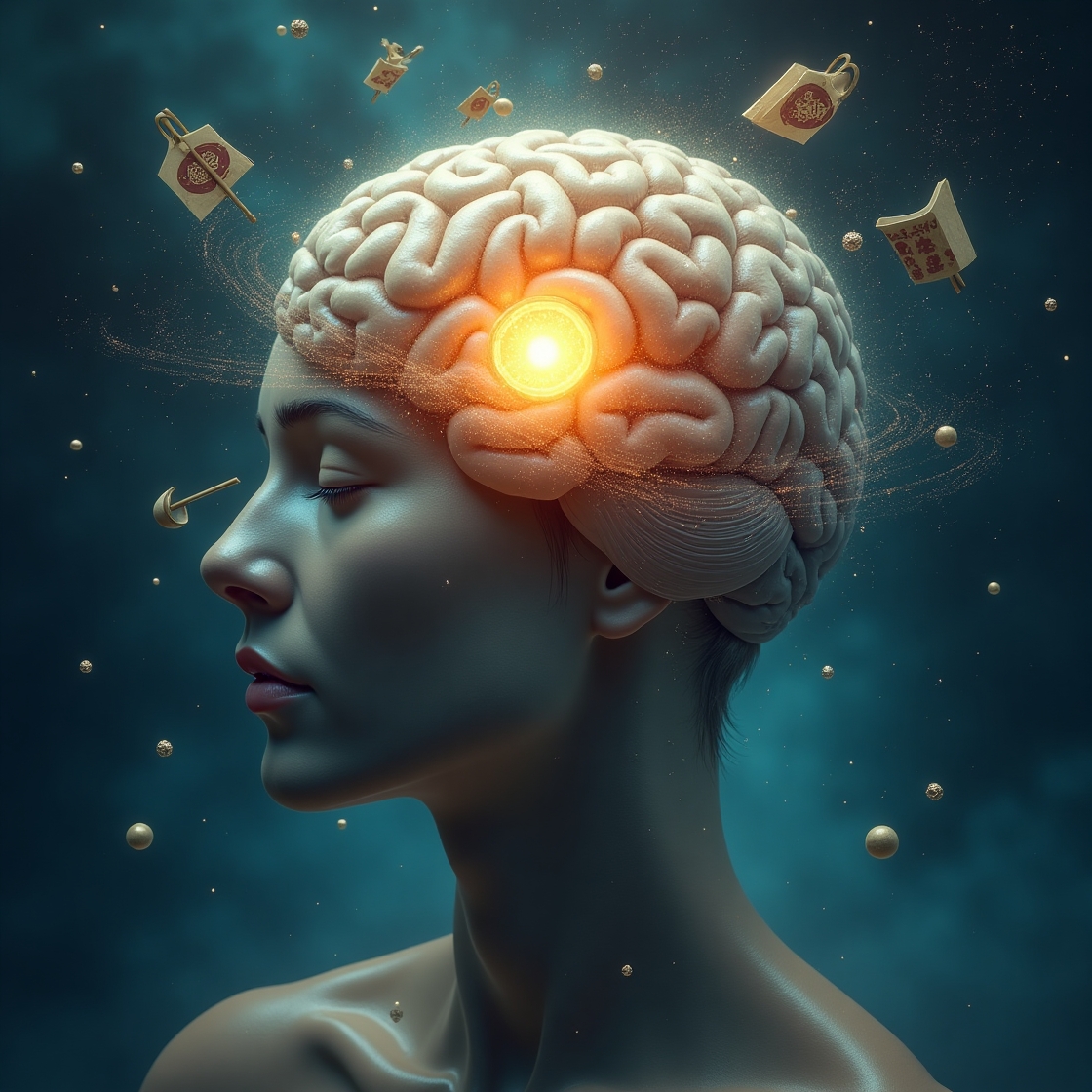
Leave a Reply